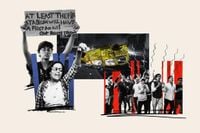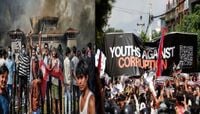In the autumn of 2025, a wave of youth-driven protest swept across two distinct corners of Asia—Morocco and Nepal—leaving governments reeling, streets thrumming with energy, and digital platforms at the heart of it all. What began as outcries against corruption, poor public services, and geriatric political elites quickly evolved into a broader generational revolt, raising urgent questions about the future of democracy, social justice, and the power of digitally coordinated activism.
On October 3, 2025, Morocco witnessed an eruption of public anger after a tragedy at Agadir Public Hospital in the country’s south: eight pregnant women died while hospitalized for caesarean sections. According to reports cited by LNGinNorthernBC, the deaths triggered a groundswell of protest, most notably led by the apartisan youth group “Genz 212.” The group, which boasts a staggering 150,000 members on Discord, demanded the resignation of the Moroccan government, denouncing its failure to protect constitutional rights and respond to basic social needs. Their call to action was clear: “We demand the dissolution of the current government for the failure to protect the constitutional rights of Moroccans and to respond to their social demands.”
Protests quickly spread from Rabat’s commercial Agdal district to Casablanca, Marrakech, and Agadir. Demonstrators, waving Moroccan flags, chanted, “The people want health and education.” The movement’s demands were as practical as they were urgent: improved health and education services, better working conditions for teachers, universal healthcare coverage, affordable medicines, and meaningful support for young job seekers and small businesses.
While most gatherings remained peaceful, the movement’s sixth consecutive night was marred by tragedy in Laqliaa, southern Morocco, where three people died during an attempted attack on a police station. The Moroccan Association for Human Rights reported that more than 350 people were injured and over a thousand detained—some arrested live on television. The protests also denounced government spending on sports events, criticizing the allocation of funds to spectacles while education, healthcare, and employment languished.
United Nations Secretary-General António Guterres weighed in, urging Moroccan authorities to conduct a “rapid and impartial investigation” into the deaths. The “Genz 212” group, for its part, emphasized its commitment to peaceful protest, urging all participants to “reject all forms of violence” and to “respect the peaceful nature” of the movement.
The Moroccan youth movement’s spontaneous, decentralized organization via Discord drew immediate comparisons to recent events in Nepal—a country that, just weeks earlier, had experienced a similarly seismic youth-led uprising. In September 2025, Nepal’s so-called “Gen Z Uprising” erupted after the government banned major social media platforms for failing to register under domestic law. The ban, intended to stifle criticism, instead became the spark that ignited a generational revolt against the entrenched political class.
As reported by MyIndMakers, the Nepali protests were not confined to a single age group. While Western media fixated on the “Gen Z” label, the movement drew in everyone from schoolchildren to adults in their fifties. Their grievances were familiar: endemic corruption, economic hopelessness, and the flaunting of wealth by the children of the elite. Youth unemployment hovered above 20%, and two thousand Nepali youth left the country daily to find work abroad—remittances accounting for over a quarter of Nepal’s GDP. The average Nepali made just $1,400 a year, a stark contrast to the opulence displayed by the so-called “#NepoKids.”
The government’s attempt to silence dissent through a social media ban backfired spectacularly. When the ban was swiftly revoked, it was too late: over seventy people had been killed in the ensuing police crackdown, and the fury spilled into the streets. Protestors burned party offices, hotels, private homes, and even the parliament building. Within days, Prime Minister K P Sharma Oli resigned and Parliament was dissolved.
Yet, the aftermath of Nepal’s youth revolution was complicated. An interim government led by former Chief Justice Sushila Karki was appointed, a move seen as a symbolic victory for the youth. But as MyIndMakers noted, real power remained with the entrenched bureaucracy and party apparatus. The system, it seemed, was poised to absorb and neutralize the very movement that had toppled the old guard.
Concerns quickly mounted about the potential co-option of the youth movement. Established political forces, some accused of infiltrating the protests and even orchestrating violence, began maneuvering to reclaim control. The interim government’s legitimacy was questioned, and the upcoming March 2026 elections loomed as a test of whether the youth could translate street power into political power.
Significant barriers remain. Millions of Nepali citizens working abroad—many of them the most disillusioned by the status quo—are excluded from voting due to the absence of absentee ballots. Age restrictions for federal office keep the youngest activists from holding real power. The risk, analysts warn, is that the movement’s energy could dissipate, leaving the old political syndicates to reassert themselves through coalition politics and backroom deals.
In both Morocco and Nepal, digital platforms like Discord and Instagram served as the connective tissue for protest—tools that enabled rapid mobilization, decentralized leadership, and a sense of collective purpose. But as these movements have shown, digital energy alone is not enough. Without structural reform, legal rights to participate, and a unified political front, youth-led uprisings risk being remembered as “a beautiful moment of fury that changes the face of the government but not the soul of the state.”
The comparison between Morocco and Nepal is instructive. In Morocco, the youth are demanding not just accountability for recent deaths, but a wholesale rethinking of social priorities—from health and education to job creation and anti-corruption measures. In Nepal, the challenge is to move from protest to participation, to build new political parties and contest elections with credible, uncorrupt candidates who can carry the torch of reform into the halls of power.
Both countries now stand at a crossroads. The youth have demonstrated their capacity to shake the foundations of entrenched systems, but their ultimate success depends on whether they can institutionalize their gains, outmaneuver old elites, and sustain their movements beyond the heat of the moment. The streets have spoken; the ballot box must now deliver on the promise of change.

